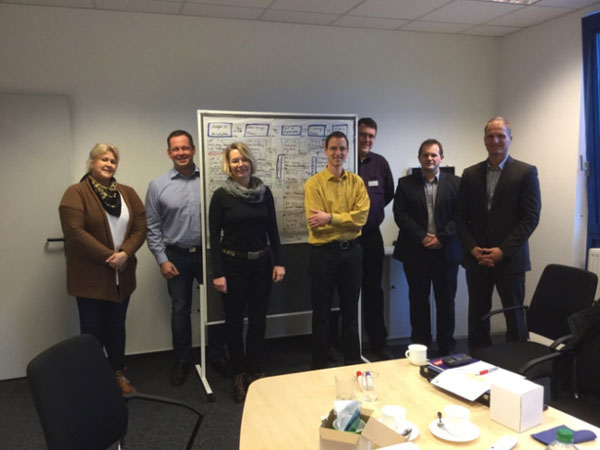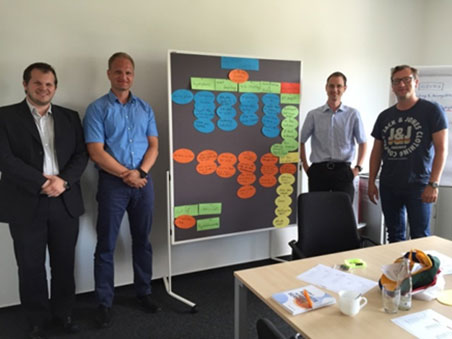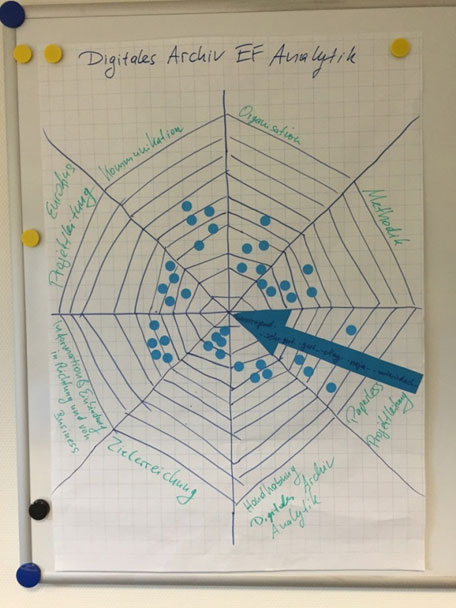Eurofins’ adoption of PRINCE2® Case Study
Case Study


Case Study

- Case Study
- Project management
- Project planning
- Project progress
- PRINCE2
June 17, 2017 |
14 min read
- Case Study
- Project management
- Project planning
- Project progress
- PRINCE2
Eurofins Scientific is an international life sciences company. They used PRINCE2® to manage a project to test the feasibility of digitally archiving documents held in paper files.
The project had challenging cost saving targets, which it achieved and using PRINCE2 also provided additional benefits in improving project delivery.
IntroductionIntroduction
The Organization
Eurofins Scientific is an international life sciences company, which provides a unique range of analytical testing services to clients across multiple industries. The group is the world leader in food and pharmaceutical products testing and within the field of environmental laboratory services. It is also one of the global market leaders in agricultural science, genomics, discovery pharmacology and central laboratory services.
Eurofins Scientific was founded in 1987 with 10 employees to market the SNIF-NMR® technology. This is a patented analytical method used to verify the origin and purity of several types of food and beverages as well as to identify sophisticated fraud that cannot be detected by other methods.
Today the Eurofins Group is a leading provider of analytical services with:
- an international network of around 200 laboratories across 39 countries in Europe, North and South America and Asia-Pacific;
- over 20,000 staff;
- a portfolio of over 130,000 reliable and validated analytical methods;
- more than 100 million assays performed each year to establish the safety, identity, composition, authenticity, origin, traceability, and purity of biological substances and products.
Eurofins is one of the fastest growing listed European companies. Since its IPO on the French stock exchange in 1997, Eurofins’ sales have increased by 40% each year (in compound average) to EUR 1.410 billion in 2014. Eurofins Information Systems GmbH, based in Hamburg, Germany, is part of the Eurofins Scientific network. Besides providing several different IT services to laboratories throughout Germany, Eurofins is also in charge of delivering projects in various fields.
Summary of the project and its outcomes
The project was to run a pilot to test the feasibility of digitally archiving documents that were currently held in paper storage. The project had challenging targets for cost savings, covering both the administration and storage of documents.
The pilot achieved its cost saving goals and the use of PRINCE2® delivered additional benefits in improving project delivery.
Choice of project management approach
The Eurofins management team considered PRINCE2 and PMI®, and decided to introduce PRINCE2 as the standard project management method because of its practicality and because Eurofins already had some PRINCE2 knowledge.
For an optimal use of PRINCE2 it was necessary to train employees in PRINCE2 and to create a specific organizational structure within the company. The first step was to start with a pilot project at Eurofins Analytik GmbH for the Digital Archive, to introduce PRINCE2 within the Eurofins network.
This Case Study highlights the added value generated through the use of PRINCE2 principles, specifically:
- steering over management
- phases steering through exception principle
- adapting to project environment (“as little as possible, as much as necessary”) learning from experience.
Background
Eurofins Analytik wanted to increase efficiency and reduce costs by eliminating the usage of paper in its document management process. They strived to introduce a sophisticated document management system (DMS) that includes archiving all documents electronically in the business process. Besides that they wanted to reduce the amount of paper used in its processes. They selected Eurofins Information Systems as project management experts because of our capability to deliver a project tailored to their challenging requirements.
In January 2015 Eurofins Information Systems received the project mandate to deliver and install a solution for digitally archiving documents at Eurofins Analytik. This posed a challenge not only because of the sheer amount of paper that had been produced in the past (50,000 sheets a month) but also because of the legal requirements to keep the documentation. Image 2.1 shows just a small part of the current paper archive.

Image 2.1 Paper archive before starting the Project Digital Archive
Aims and objectives
The overriding goal was to set a company-wide standard (“Gold standard”) for archiving documents. The Digital Archive Eurofins WEJ Analytik GmbH project was created to support this goal. The solution enabled Eurofins Analytik to digitally archive all emerging documents (emails, assignment documents, analytical reports, invoices, etc.) along with the business process in order to eliminate the existing physical archive. Figure 3.1 shows a process model with embedded digital archiving. The first step of the programme has been to archive all documents that have been generated within the whole process. In 2017, the second step will be to digitize the process.

Figure 3.1 The target archiving process.
The project defined a set of supporting stages, activities and milestones to help reach the overall goal. Some of the most relevant were:
- modelling of a software-based process
- automatic digitizing and archiving of documents produced along the process
- installation of a scan station for physical documents
- sourcing and installation of necessary hardware
- sourcing and installation of software (first of all the document management system)
- definition of a data and index model for document archives
- development of training and communication concepts.
The rationale for the project was to improve document archiving and provide efficiency and cost savings. Targets were set to prove the value of the pilot project:
- efficiency increase during the administration of documents (80%)
- reduction of search and retrieval times
- reduction of archived documents (70-80%) reduction of storage costs (70%).
A set of key performance indicators (KPIs) was used to measure the success of the project. The most relevant were:
- time required for archiving documents
- time period for searching for documents
- required length of shelf metres
- storage costs.
Approach
The project started with a period of intense research on the topic including relevant knowledge from both inside and outside the company. This approach helped us to develop the project idea further.
Following this, we evaluated applications from a range of software providers and selected the software package d.3 from d.velop with which we started the detailed planning.
Key milestones
The project plan was intended to be brief and the defined milestones with their activities and dates are shown in Table 4.1:
| Milestones | Activities | Date |
|---|---|---|
Project preparation | Evaluation of necessary hardware Approval of project resources Planning and preparation of kick-off workshop | 16/01/15 |
| Kick-off / project start | Team-building Agreement on work packages Agreement on dates Appointment of person responsible | 19/01/15 |
| Project work | Handling of work packages Status web conferences Generation of deliverables | 31/03/15 |
| Project review | Presentation of results Agreement and termination of rework | 13/04/15 |
| Project approval | Approval of contractor Decision-making on future project(s) in other business units Initiation of follow up project Approval of contractor Decision-making on future project(s) in other business units Initiation of follow up project | 30/04/15 |
Table 4.1 Project milestones
Project preparation
During the initiation phase, we defined the following set of PRINCE2 management products for the project.
- Communication management strategy. This established clear communication channels and document management requirements for the project.
- Communication channels
- A weekly status call between Project Manager and Team Manager.
- The escalation route for project issues was defined to be: Sub-Project Manager – Project Manager – Project Steering Committee.
- The Sub-Project Managers were responsible for communicating relevant information to their work package stakeholders.
- Document management
- Project documents and other project specific documents were stored on the Eurofins Microsoft SharePoint®. Relevant project stakeholders (e.g Project Team, Project Steering Committee) were able to access the documents.
- The work breakdown structure was created and administrated using Mindjet MindManager®. – Based on the work breakdown structure, Microsoft Outlook® tasks were created and assigned to the relevant responsible person. – The work breakdown structure has been synchronized regularly (Outlook tasks linked to the work breakdown structure in Mindjet MindManager) and therefore represented the actual status of the project.
- Information, results and testing to be recorded in writing.
- In addition to the PRINCE2 product-focused approach, Eurofins created work breakdown structures which were provided to the project board at the end of every project phase with the final reports. The final report also served as a reporting tool for deviations from the planned output and for the approval of additional resources. The project board was in charge of approving the final reports using the approval functionality available in Outlook.
- Communication channels
- Quality management strategy. The strategy covered the definition and ongoing review of acceptance criteria, and definition of a meaningful testing environment.
- Risk management strategy. The risk management approach was designed to support the execution of Failure Mode and Effect Analysis (FMEA).
- Configuration management strategy. The strategy focused on configuration within the work packages. At this point we made the conscious decision to apply the PRINCE2 principle of “learning from experience”. We customized the basic solution from d.3 step by step to match Eurofins’ requirements. There was an ongoing harmonization of quality criteria because it was not possible to define the final solution upfront.
- Business case. The business case was defined using a calculation of the return on investment (ROI), see Figure 4.1. It was never compromised due to the clear goal and adherence to the set tolerances. The deployment was clearly defined upfront and we found that a deployment revision plan was not necessary.

Figure 4.1 Return on investment calculation
Kick-off / Project start
The kick-off workshop was the starting point for the project. The workshop included the whole project team and was a lot of fun, producing good results for the start of the project, see image 4.1. In the workshop we defined the necessary work packages, which included each responsible person, the duration of the work and estimated expenditure. The workshop started the analysis and concept phase, served as a platform for team-building and helped create a common understanding for the goals of the project.

Image 4.1 Kick-off workshop with the whole project team
Project Work
We chose Mindjet MindManager to help manage project information as it allowed us to link all existing notes, graphics and links to each work breakdown structure, which was updated at least after every status call.
At the transition of phases we coordinated and refined work packages with the project team, if necessary.
Project Review
Following the PRINCE2 principle of management by stages, the project board had to review and approve each project phase report before agreeing the next phase of the project.
We had regular status calls to discuss and, if necessary, adjust the risk matrix, the deliverables and their acceptance criteria.
The formal review of the commercial justification of the project (need of the project for the company) took place after the completion of the project and was not measured during the project. Despite that, the commercial justification was never questioned by the project board during the project.
Experiences and insights have been recorded in protocols as well as the final project documentation.
Project Approval
Project approval was made really easy because all the targets were hit on time and the project did not need more budget (costs) than expected. The management was very happy about the project work and of course about the implementation of the digital archive.
Approval of the first project triggered initiation of the rollout programme for 2016, using PRINCE2 of course. This will implement the digital archive in every destination of Eurofins Food in Germany. It started on 1 June to prepare for the kick-off in Berlin on 21 July. The big goal is to finish the project at the end of the year with the digital archive working in 16 business units. The next stage in 2017 is to work with each business unit in order to digitize their data handling and archive processes. Some of our processes are already digital but we have to work with our customers to hit this target.
Challenges
The biggest challenge was the collaboration with the external service provider. There were major hurdles in establishing a common understanding of project management and a focus on the project goals. A great amount of effort went into communication to keep the project on track. The lesson for future projects is to include additional time in the plan for communication to ensure a common understanding within the project team.
Another challenge was the validation of the scan process to ensure that the quality of the scanned documents was good enough for storage and retrieval. For future projects we will plan additional time for this task as well.
Lessons
Immediately after the project we held a lessons learned workshop with relevant stakeholders (see image 6.1) to analyze positive and negative aspects of the project.

Image 6.1 Lessons learned workshop
The project team assessed the performance of different project management aspects in a spider chart, see Figure 6.1. These covered:
- Organization (Organisation)
- Methodology (Methodk)
- Paperless (external service) project management (Paperless Projecktleitung)
- Handling the Digital Archive analysis (Handhobung Digitales Archiv Analytik)
- Goal achievement (Zielerreichung)
- Two-way communication between the business and project teams (Information und Einbindung in Richtung und von Business)
- Eurofins project management (Eurofins Projektleitung)
- Communications within project (Kommunikation)
The blue arrow shows the classification of performance from bad, at the edge of the chart, to very good at the centre.

Figure 6.1 Net diagram showing the performance of several aspects of the project – rating from project team
What went well?
Some aspects of the project that worked very well were:
- Good organization of the project
- Project finished on time and within the tolerances
- All the goals were met
- New opportunities were identified and implemented (e.g. search integration in production system; active directory connection)
- Implementation of an easy-to-use solution
- Completion of additional work packages (e.g. integration of delivery notes into the document portfolio)
- Communication within the project team
- Good communications with third party suppliers (e.g. d.velop; Canon).
What didn't go well?
However there were some aspects of the project which did not go as well and provided lessons for improvement:
- One of the findings of the lessons workshop, after the project, was that the kick-off workshop had not been properly tailored for the participants. This has been noted for future projects.
- Communication with stakeholders outside the project team did not provide them with all the information they needed.
- Delivery time of hardware. To overcome this we used another machine (an old application server) as the test environment. After the hardware was delivered we were able to migrate the configuration into the production environment.
- Backup procedure was not clarified upfront. The project was able to make use of spare capacity in the IT infrastructure team on a temporary basis.
- Internal standards (e.g. encryption of documents) were considered too late. However, because some of the outputs were delivered ahead of schedule, we were able to catch up using freed capacity in the project team.
- Late integration of IT infrastructure. The effect of this was minimized by the ability to use the test environment mentioned above.
Conclusion
Successes
Overall the project was a success and delivered the output we wanted within the timeframe. We have also learned some lessons that will help improve the processes for future projects.
In addition to a successful project outcome, the project has demonstrated the value of adopting PRINCE2 as Eurofins’ project management standard. In summary the key benefits were:
- Management across phases created transparency, trust and pooled project work; product orientation.
- Defined communication channels created efficient and effective project work.
- Continuous quality checks have been performed. Corrective action has been taken quickly.
- Learning from experience enabled some agility in favour of the end product of the project.
- Risks have been monitored and avoided early.
- The work with the work breakdown structure kept everyone up to date and allowed a clear and transparent delegation of work packages. No resistance arose, everyone knew what to do.
- The biggest success factor was great collaboration and trust within the project team.
Future use of PRINCE2
As a result of the experience with this project:
- The PRINCE2 based method has been successfully introduced into practice and is established across the company.
- The management and the whole organization strongly believe in application of the method.
- The Digital Archive is currently in use at Eurofins Analytik GmbH and further sites are in preparation.
- We won second place at the BPUG Germany’s PRINCE2 Best Practice Award 2015.
What people said
“It is easier than the past to support our customers.”
“Very efficient and intuitive.”
“After some scepticism now I am absolutely confident.”
“The office is very tidy and now it is better to work with a lot of data without so much paper.”
Axelos' view
Eurofins has successfully adopted PRINCE2 as its standard project management method. In following the key principles of the method and adapting the documentation and processes for their own project environment, they have created a robust project management approach.
By testing the approach with a pilot project they have learned some valuable lessons to further improve their application of the method. The success of the pilot has proved the approach to the management of Eurofins, leading to its roll out in the rest of the company.
About the author

Nico Droschinski is the manager of Customer Service Process Engineering in Eurofins Information Systems GmbH.
He has had various roles in the food industry since 2003, including, laboratory technician for a dairy company, customer services consultant, business analyst and sales and customer care process engineering.
Outside of work Nico enjoys the beach and Jiu Jitsu. He lives in Hamburg with his family.